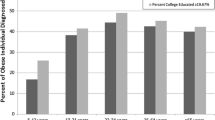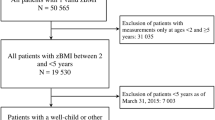Abstract
Background
Published studies do not consistently find overweight and obesity to be associated with higher medical expenditures for US children. Previous analyses use varying samples and methods, making results difficult to compare.
Objective
To examine whether methodological choices or temporal trends are driving differences in estimates of the association between weight and pediatric medical expenditures.
Methods
We analyzed the medical expenditures and use of 6- to 17-year-old individuals in the 2006–2010 US Medical Expenditure Panel Surveys. The impact of overweight and obesity on annual medical expenditures and use was assessed, controlling for age, income, race, sex, geographic region, urban/rural residency, insurance status, and survey year. A two-part regression model, in which part one estimated the likelihood of incurring any expenditure and part two estimated non-zero expenditures, was used to predict total expenditures. Expenditures were inflated to 2012 dollars using the medical care component of the Consumer Price Index. Poisson and logistic regression models were used to predict differences in healthcare use between normal weight, overweight, and obese youth.
Results
We found that overweight and obese youth have higher, but not significantly higher medical expenditures than normal weight youth. Conclusions were robust to various methodological assumptions. We found that obese adolescents have a higher use of prescriptions drugs and healthcare visits compared with normal weight youth (0.04–1.3 visits), but differences in use only translated into marginally higher expenditures.
Conclusions
These findings may reflect new trends in healthcare use among obese youth. Future research should assess whether services are being underused by obese youth and the impact of persistent obesity on long-term medical expenditures.
Similar content being viewed by others
References
Ogden CL, Carroll MD, Curtin LR, Lamb MM, Flegal KM. Prevalence of high body mass index in US children and adolescents, 2007–2008. JAMA. 2010;303(3):242–9.
Reilly JJ, Kelly J. Long-term impact of overweight and obesity in childhood and adolescence on morbidity and premature mortality in adulthood: systematic review. Int J Obes (Lond). 2011;35(7):891–8.
Buescher PA, Whitmire JT, Plescia M. Relationship between body mass index and medical care expenditures for North Carolina adolescents enrolled in Medicaid in 2004. Prev Chronic Dis. 2008;5(1):A04.
Estabrooks PA, Shetterly S. The prevalence and health care use of overweight children in an integrated health care system. Arch Pediatr Adolesc Med. 2007;161(3):222–7.
Hampl SE, Carroll CA, Simon SD, Sharma V. Resource utilization and expenditures for overweight and obese children. Arch Pediatr Adolesc Med. 2007;161(1):11–4.
Janicke DM, Harman JS, Jamoom EW, Simon SL, Zhang J, Dumont-Driscoll M. The relationship among child weight status, psychosocial functioning, and pediatric health care expenditures in a medicaid population. J Pediatr Psychol. 2010;35(8):883–91.
Bell JF, Zimmerman FJ, Arterburn DE, Maciejewski ML. Health-care expenditures of overweight and obese males and females in the medical expenditures panel survey by age cohort. Obesity (Silver Spring). 2011;19(1):228–32.
Monheit AC, Vistnes JP, Rogowski JA. Overweight in adolescents: implications for health expenditures. Econ Hum Biol. 2009;7(1):55–63.
Trasande L, Chatterjee S. The impact of obesity on health service utilization and costs in childhood. Obesity (Silver Spring). 2009;17(9):1749–54.
Johnson E, McInnes MM, Shinogle JA. What is the economic cost of overweight children? Eastern Econ J. 2006;32(1):171–87.
Skinner AC, Mayer ML, Flower K, Weinberger M. Health status and health care expenditures in a nationally representative sample: how do overweight and healthy-weight children compare? Pediatrics. 2008;121(2):e269–77.
Turer CB, Lin H, Flores G. Health status, emotional/behavioral problems, health care use, and expenditures in overweight/obese US children/adolescents. Acad Pediatr. 2013;13(3):251–8.
Finkelstein EA, Trogdon JG. Public health interventions for addressing childhood overweight: analysis of the business case. Am J Public Health. 2008;98(3):411–5.
BLS, Bureau of Labor Statistics. Consumer Price Index. 2012 (cited 2013 September 1). http://www.bls.gov/cpi/home.htm.
Medical Expenditure Panel Survey. In: AHRQ AfHRaQ, editor. Rockville: AHRQ; 2010.
Fryar CD, Ogden CL. Prevalence of underweight among children and adolescents: United States, 2003–2006: Centers for Disease Control and Prevention; 2012.
Centers for Disease Control and Prevention National Center for Health Statistics. CDC growth charts: United States. 2000 (cited September 30, 2010). http://www.cdc.gov/growthcharts/.
Centers for Disease Control and Prevention. About BMI for children and teens. 2009 January 27 (cited 2009 September 29). http://www.cdc.gov/healthyweight/assessing/bmi/childrens_BMI/about_childrens_BMI.html.
Akinbami LJ, Ogden CL. Childhood overweight prevalence in the United States: the impact of parent-reported height and weight. Obesity (Silver Spring). 2009;17(8):1574–80.
Ogden CL, Carroll MD, Kit BK, Flegal KM. Prevalence of obesity and trends in body mass index among US children and adolescents, 1999–2010. JAMA. 2012;307(5):483–90.
AAP, American Academy of Pediatrics. Pediatric medical cost model. 2009 (cited 2011 April 3).
Haddix AC, Teutsch S, Corso PS. Prevention Effectiveness: A Guide to Decision Analysis and Economic Evaluation. 2nd ed. New York: Oxford University Press; 2003.
Perrin JM, Bloom SR, Gortmaker SL. The increase of childhood chronic conditions in the United States. JAMA. 2007;297(24):2755–9.
Manning WG, Mullahy J. Estimating log models: to transform or not to transform? J Health Econ. 2001;20(4):461–94.
Lipscomb J, Ancukiewicz M, Parmigiani G, Hasselblad V, Samsa G, Matchar DB. Predicting the cost of illness: a comparison of alternative models applied to stroke. Med Decis Making. 1998;18(2 Suppl):S39–56.
Buntin MB, Zaslavsky AM. Too much ado about two-part models and transformation? Comparing methods of modeling Medicare expenditures. J Health Econ. 2004;23(3):525–42.
StataCorp. Stata Statistical Software: Release 12. College Station: Statacorp LP; 2011.
Duan N. Smearing estimate: a nonparametric retransformation method. J Am Stat Assoc. 1983;78:605–10.
Homer CJ, Fowler FJ, Gallagher PM, Shaul J, Uyeda M, Zaslavsky A, et al. The Consumer Assessment of Health Plan Study (CAHPS) survey of children’s health care. Jt Comm J Qual Improv. 1999;25(7):369–77.
Lin Y. Association of Body Mass Index and Prescription Drug Use in Children from the Medical Expenditures Panel Survey, 2003–2006. Seattle: University of Washington; 2010.
Patient Protection and Affordable Care Act. 111–148. United States; 2010.
Drummond M, Barbieri M, Cook J, Glick HA, Lis J, Malik F, et al. Transferability of economic evaluations across jurisdictions: ISPOR Good Research Practices Task Force report. Value Health. 2009;12(4):409–18.
Archer K, Lemeshow S, Hosmer D. Goodness-of-fit tests for logistic regression models when data are collected using a complex sampling design. Comput Stat Data Anal. 2007;51(9):4450–64.
Wenig CM. The impact of BMI on direct costs in children and adolescents: empirical findings for the German Healthcare System based on the KiGGS-study. Eur J Health Econ. 2012;13(1):39–50.
Janssen I, Lam M, Katzmarzyk PT. Influence of overweight and obesity on physician costs in adolescents and adults in Ontario. Canada. Obes Rev. 2009;10(1):51–7.
Kuhle S, Kirk S, Ohinmaa A, Yasui Y, Allen AC, Veugelers PJ. Use and cost of health services among overweight and obese Canadian children. Int J Pediatr Obes. 2011;6(2):142–8.
Au N. The health care cost implications of overweight and obesity during childhood. Health Serv Res. 2012;47(2):655–76.
Vellinga A, O’Donovan D, De La Harpe D. Length of stay and associated costs of obesity related hospital admissions in Ireland. BMC Health Serv Res. 2008;8:88.
Woolford SJ, Gebremariam A, Clark SJ, Davis MM. Incremental hospital charges associated with obesity as a secondary diagnosis in children. Obesity (Silver Spring). 2007;15(7):1895–901.
Kuhle S, Kirk SF, Ohinmaa A, Veugelers PJ. Comparison of ICD code-based diagnosis of obesity with measured obesity in children and the implications for health care cost estimates. BMC Med Res Methodol. 2011;11:173.
Trasande L, Liu Y, Fryer G, Weitzman M. Effects of childhood obesity on hospital care and costs, 1999–2005. Health Aff (Millwood). 2009;28(4):w751–60.
Weden MM, Brownell PB, Rendall MS, Lau C, Fernandes M, Nazarov Z. Parent-reported height and weight as sources of bias in survey estimates of childhood obesity. Am J Epidemiol. 2013.
Acknowledgments
No sources of funding were used to assist in the preparation of this manuscript. The authors have no conflicts of interest that are directly relevant to the content of this manuscript.
Author contributions
DRW and LAP were responsible for the study concept and design. DRW was responsible for the analysis and interpretation of data and drafted the manuscript. DRW and LAP reviewed the manuscript for intellectual content and approved the final manuscript. DRW is the guarantor for the overall content of the manuscript.
Author information
Authors and Affiliations
Corresponding author
Electronic supplementary material
Below is the link to the electronic supplementary material.
Appendix
Appendix
CAHPS questions:
-
1.
Is there a particular doctor’s office, clinic, health center, or other place that [child] usually goes if [child] is sick or needs advice about [child]’s health?
-
a.
Yes
-
b.
No
-
a.
-
2.
In the last 12 months, how often did [child] get an appointment for regular or routine health care as soon as you wanted?
-
a.
Never or Sometimes
-
b.
Usually or Always
-
a.
-
3.
Has a doctor or other health provider ever given advice about [child] eating healthy?
-
a.
Yes
-
b.
No
-
a.
-
4.
Has a doctor or other health provider ever given advice about the amount and kind of exercise, sports, or physically active hobbies [child] should have?
-
a.
Yes
-
b.
No
-
a.
-
5.
How many times [child] went to a doctor’s office or clinic for care:
-
a.
0
-
b.
1
-
c.
2
-
d.
3
-
e.
4
-
f.
5 to 9
-
g.
10 or more
-
a.
Rights and permissions
About this article
Cite this article
Wright, D.R., Prosser, L.A. The Impact of Overweight and Obesity on Pediatric Medical Expenditures. Appl Health Econ Health Policy 12, 139–150 (2014). https://doi.org/10.1007/s40258-014-0088-7
Published:
Issue Date:
DOI: https://doi.org/10.1007/s40258-014-0088-7




